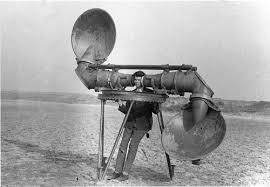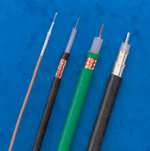BEGINNERS GUIDE TO AMATEUR TV
I WILL ASSUME YOU ARE ALREADY LICENSED BUT A TV NOVICE.
One of the first things to do if you are interested in getting involved in Amateur TV is to establish whether there are any ATV signals being sent in your area. Monitoring on 2 metres should give you an idea of any local activity.The usual ATV talkback channel on 2 meters band is 144.75 Mhz. Some use 70cms. VHF polarity is usually vertical though some stations do use horizontal. This may vary from area to area and on different repeaters. 70cms is used for some talkback, especially if a suitable repeater is available. You may only hear one side of the conversation of course until you can receive on 23cms. Look at the LINKS page for suppliers of equipment described here. The BATC website www.batc.tv carries streamed feeds of most ATV repeaters in the UK so take a look there for more details. A list of current 23cm ATV repeaters is at www.ukrepeater.net/23cmtv.htm many of these repeaters relay the 2m talkback channel so that you can hear both sides of the contact..



If
you have a repeater near you then a receiver can be used alone but normally you will require a preamp. A decent aerial and a pre-amp will be required.
A popular solution for analog reception is to use a Comtech receiver . Available from
2 sources in the uk and on Ebay (see links page), they give 625 line colour
picture from a 23cms signal input. Given a decent yagi aerial up on the chimney
etc it will work well with local signals even without a preamp. If your local repeater is digital output buy a suitable FTA satellite box. As the LNB input on the receiver covers the 23cms band there is no need for a converter (or an LNB!) just connect the serial straight into the F socket at the rear of the receiver. Dont forget that the aerial will be a short-circuit to the dc volts sent up to power the LNB so switch it off in the firmware menu of the receiver first. See here for more details. You may have to set the LNB Offset frequency to 10000. This will let you enter the desired frequency with a 1 in front i.e 1308 MHz would be entered as 11308. FEC should be auto and the symbol rate is 4000 Ms/s.
Many local
Repeater outputs from 1304 to 1318Mhz. To find your local area repeater see the REPEATERS list.
ANALOG:
The first decision these days is whether to use an analog or digital transmitter. Up until a few years ago there was really no choice it had to be analog due to the cost of going digital. The Comtech boards were the popular route to getting analog signals out. The transmitters were about £30 and the receivers around £40. These were adapted from non-standard CCTV units and needed some modifications to get a satisfactory signal. They use DIL switches to select frequency and a controller board with LCD was designed to simplify tuning. The
Comtech analog transmitters give less than 100 milliwatt rf out, so a pre-PA amplifier
will be needed. The snag with analog is that whilst it gives a superb picture on a strong local signal, it soon drops into a noisy speckly picture as signal strength drops away whereas digital is crystal clear until the signal drops away completely ,whereupon you are left with either a frozen screen or worse a blank one. Bandwidth these days has become a problem and the formerly clear 23cms band has been chipped away at by the commercial Primary Users (Radar etc) so if you are starting from scratch I suggest that unless you have a repeater nearby to do the conversion for you, digital is probably the wise choice for the future. The local (Bournemouth) repeater GB3SQ is the UKs first digital-only ATV repeater, but will only be the first of many in my opinion. Most of the existing repeaters can now cope with analog or digital in and tend to transmit digital out. Repeater Keepers realised that it was a good idea to incorporate a digital encoder into their repeater to enable the analog incoming signals to be converted to digital for the retransmitted signal. This meant that cheap satellite receivers could be used for receiving the signals.
The receivers are the Satellite receivers which are plentiful but they must be able to decode the low data format (generally 4 Ms/s) signals. SKY boxes and Terrestrial boxes are not useable for ATV.
Previously, the digital MPEG2 encoders were only available from commercial companies who were upgrading their equipment and allowed their old encoders to go to the amateur community or the new SR Sytems digital encoders which were about £600. Now there are two other, cheaper options. The BATC have had a commercial MPEG4 encoder board modified to use a MPEG2 encoder chip, this makes a simple ready to switch-on and go transmitter (very low rf output so the usualy 2 stages of boost will be needed to get full output from your PA). Costing about £400 it is a saving over the SR Systems option. However if you are handy with a bench magnifier and soldering iron there is now also a homebrew option , the DigiLite. This will set you back under £150 but needs a PC to do the serialising using either a PCI card PVR or an external USB Hauppage PVR box .Details elsewhere on this website.
Usually an intermediate amplifier to raise the rf to the 150 -500mW level is used and then a main PA giving up to 25w. Mitsubishi modules RA18H1213G are popular for PAs and each give about 18Watts of rf out at 23cms. They can be used individually, in pairs (35watts) or fours, giving a power of over 100 watts. The new versions require a drive of only 150mW each, the old ones needed 1 watts rf. They also give more output power too. There are kits and ready-made modules which will provide this drive level. See LINKS page. The linearity needs to be good for the wide bandwidth atv signals. Even more so in the future as we increasingly go over to digital. These modules are very low efficiency and generate more heat than rf ! A good PSU and heatsink and fan(s) are essential. The one module PA needs about 8A at 14v, the two module unit needs 16A at 14v; 4 module unit needs about 30 amps at 14 volts. Quiescent current (no rf drive into PA) should be 1 to 2A for single chip, 3 to 4A for dual chips PA.
An important piece of test equipment you will certainly need at some point is a 23cms swr/power meter. It allows you to tweak the equipment for maximum power out and equally important to ensure that as little as possible returns back from the aerial. Ironically this little piece of equipment actually costs more than the PA devices. If you are setting up for ATV you will probably be able to borrow one to check your aerial system from a local operator or take a look for a secondhand one.
Some form of switching between different video sources will eventually be needed, a simple video and audio switchbox as used for video recorders etc is fine. A true mixer with total fade is not normally an option as this requires all equipment to be syncronised to a central timebase, not normally possible to achieve with domestic camcorders etc.(when you drop the level of the video waveform you also drop the level of the sync pulses too but even if you strip the syncs off first there is always a difference in the timing between the different sources) Mixers such as the Panasonic MJAVE5 convert both inputs to digital and then back to analogue allowing mixing and crossfade effects to be produced and can be found on Ebay for about a hundred pounds. They are rather wide to have on a small bench, however.
Computer
Any computer with a TV out card should do, but not easy to find these days, so you might need to use a VGA to video adapter (Ebay) or a DVI to composite video convertor to get the composite video feed to send to the modulator. The PC is useful for testcards etc but a camera can usually go strraight into the modulator or encoder
Sound.
A gooseneck microphone through the sound card of the computer is a way
of producing sound, some camcorders have in-built microphones but can
sound rather 'distant' unless a wide angle lens allows you to be just
a few feet from the camera. If you are listening to the 2 metre talkback
through the speaker of the receiver it is best to keep the microphone
as far from the speaker of the receiver as possible to avoid feedback.This
is preferred to headphones, apart from the inconvenience of headphones,
it can be useful for other viewers to be able to hear the other half of
the conversation where the 2metre coverage is poor. However on digital signals it can be less of a problem because of the near half-second delay during encoding.
TV
camera.
An old camcorder- perhaps one with a broken tape mechanism - is ideal, ensure that it gives a PAL composite (analog) video output. In a temporary set-up a webcam through the computer using a graphics
card with a 'tv out' feature will get you on air. You dont have to send BBC-quality pictures, just getting pictures out for others to see will be fine to start with, and remember the guys on air already will know just what an achievement it is to get a tv signal up and running and may well have useful tips and bits and pieces in their junk boxes that you can use. Remember that Ham Radio and ATV is all about discovering radio communication and learning, then passing that knowledge and experience on to others Make yourself known to a local group on 144.750 the main local talkback channel (Repeaters may use other frequencies so take a look a the BATC Forum pages first).
Monitor
tv
Any 625 line colour tv with either a SCART socket or an RCA/phono video input. If you cant get one with SCART or phono input then you could use a converter box to get to DVI or HDMI.
An easy source of ATV information is held on the BATC site, by joining the club you can access their excellent magazine, CQTV, the last 10 years of which are available for free download to members. Currently E-membership is only £6 a year. Another good magazine is the on-line free CQ_DATV magazine monthly download.
Making printed circuit boards for yourself.
A basic Testcard..
To make your own aerials see AERIALS
or
for aerial suppliers see the LINKS page.
A
list of ATV repeaters is available on this link.
Getting started with ATV : BATC.
23cms Very Low Noise preAmp kit from G4DDK.
Click here to get a MENU

